


Located in the center-west of Kozak, Aşağıbey is one of the region’s two central villages, in contrast with Demircidere, Okçular, Ayvatlar, Hisarköy, Göbeller and Aşağıcuma. It has natural Stone Pine areas, and 90% of its revenue comes from pine nuts.
Aşağıbey has very large vineyards, and there are ongoing efforts to improve them. The village is wealthy, and few of its middle-aged and older women work. As these women show little knowledge or interest in Stone Pine cultivation, the Form “H” study was not judged to be worthwhile for them. However, the village also has a large number of young women, and as they showed an interest in the study, they were included in the research.
Children in the village don’t usually continue their studies past primary school, since the income of the people is quite high.
Located in the north of the region, the village of Çamavlu has both natural Stone Pine areas and planting sites, and its trees have recently started yielding products. Its Stone Pines have been growing in value since 1972. The villagers initially cut down oak trees on their own lands and replaced them with Stone Pines. At present, 10% of the villagers have enough Stone Pines to meet all their needs. Within the boundaries of the village are 2-B lands,** and the villagers want these lands to be granted to them through afforestation or planting with Stone Pines.
The most important source of livelihood in the village is animal husbandry. Çamavlu has a rural development cooperative for promoting animal husbandry and making use of the animals’ milk. While the village’s animal husbandry is under development, the cooperative has a deficit of raw materials, yet it is still useful for setting prices for milk in the region. Women and men work together in the village. The women usually take care of animals, work in the agricultural sector for a daily wage, or collect the pine nuts which men get down from trees. The men get these nuts down, transport them to processing facilities, or help women tend to the animals. Village women are quite knowledgeable and showed great interest in our study. The villagers put great emphasis on education and training, as they believe that more education will result in better socioeconomic conditions and a higher standard of living.
The women and men of Demircidere, a village at the northwest edge of the region, enjoy an equal status in community relations. After Kıranlı, Demircidere was the village with the highest rate of women showing in the study. All work in the village is done commonly by both sexes, and there is equal work sharing. Both work together in their own vineyards and olive gardens, and in addition, the women work on other villages’ farmlands as daily workers. Women are extremely knowledgeable and quick to get involved. Within the boundaries of Demircidere, individuals have registered natural Stone Pine lands. In addition, individuals also work for afforestation through their own efforts. Demircidere is located just across the border from the province of Balıkesir, and the natural distribution area of Stone Pine ends at the village boundary, with Pinus brutia forests starting just beyond. These two pinus species naturally separate from each other. However, Stone Pine afforestation has also recently been initiated in villages of Balıkesir with the help of the forest district directorate. Within Demircidere, afforestation has been pursued in places suitable for Stone Pines in response to villagers’ demands. One of the most important sources of the village’s livelihood is the cultivation of grapes, which are used to make wine, jam and raisins. Homemade wines from the village fetch good prices. The Kozak grape is also a key as a product whose cultivation has only begun recently.
There are 500 ha of Stone Pine lands in Demircidere, all privately owned. The village falls outside the category of forest villages, as there is no productive state forest within its boundaries.
Another source of livelihood for the village is olives. Locals have recently begun channeling increased profits from pine nuts into buying olive groves in Edremit and Ayvalık. Almost all of the villagers have summerhouses or olive yards there.
There is a tea garden in the village managed by a local woman. Villagers hold celebrations such as wedding ceremonies here, women and men together. The tea garden also serves passers-by since the village is located at a crossroads. Villagers’ products are also sold here, in an example of small-scale ecotourism. This village differs from Kozak’s other villages for this reason. Villagers raise local species of livestock to provide for their own needs.
Demircidere villagers are bound to custom, and they continue to wear their traditional local clothes for both daily life and special celebrations. The village is Kozak’s most colorful in terms of the look and lifestyle of its women (Figure 3.1).
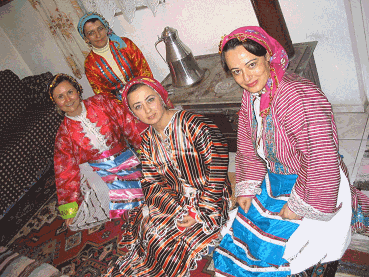
Figure 3.1. The traditional clothes of Demircidere women.
Located in the northwest of the region, Kaplan boasts the most Stone Pines in the Kozak region belonging to the village legal entity. The village was excluded from the forest village definition by the 1980 law. There is no productive state forest within the boundaries of the village, as all its lands are privately owned and registered.
Kaplan’s legal entity receives the tender value by the “küner” piece and stores them. When the village needs money, they sell their “küner” piece by piece for cash. Procurements are done by tender, and the buyer receives the tender by auction. Registered Stone Pine areas owned by individuals are usually small plots.
There are large Stone Pine lands under the ownership of Kaplan’s village legal entity. Products are collected by tender, thus ensuring quite high revenues for the village budget. The village legal entity has bought three vehicles to serve the village. It has in addition made substantial contributions to the town budget and procured a vehicle for the local governor’s office
Kaplan has established an efficient system for bearing the costs of drinking water and other water usage costs in the village. Under this system, the water bill for the whole village is met from the village legal entity budget on behalf of the villagers.
Located in the eastern edge of the region, the village of Karaveliler has no natural Stone Pine growing areas, and all such lands have been established by afforestation. Its villagers first started planting Stone Pines themselves in 1960, and a total of 450 ha has been planted to date. Everybody in the village has 10 ha or more Stone Pine lands, and a study has been done on planting a further 250 ha. The villagers’ demand for Stone Pine afforestation is continuing. In terms of age, trees are still in their twenties and have recently begun yielding products. The harvest volume and the resulting income is set to rise over time. Newly planted Stone Pine lands were distributed to households by random draw.
Karaveliler’s other income sources are animal husbandry and apiculture. The Stone Pines have yielded good products for the last 2 years, and the resulting income has improved the villagers’ economic situation. Consequently, they have increased their investments into animal husbandry and apiculture. Women usually work on animal husbandry and cultivation in the village. Interviews and studies were not conducted with the women since they work in the lands till late and are not present in the village proper.
There is a boundary dispute between Karaveliler and neighboring Yukarıbey over grazing land. The land in dispute is actually state land planted with Stone Pines. Both villages want the right to use the land. A resolution so far remains elusive.
Most of the lands in the village are very badly organized, and their terracing practices make erosion control impossible. Planting Stone Pines on these lands was meant to prevent erosion and flood problems. All afforested lands are registered lands. Some 5,000 ha of the lands have been planted by renting them on behalf of the village legal entity.
Currently Stone Pines are a good source of income; however, the villagers fear that in the future problems might occur due to a rising supply of their product, thus leading to diminished returns. To guard against this risk, therefore, the villagers are seeking alternative income sources.
The village of Kıranlı is located in the eastern part of the region. Like Karaveliler, it lacks natural Stone Pine areas. The present growing areas are private afforestation areas which have only recently started yielding products. The village has a continental climate. Kıranlı lacks any other income source beyond local animal husbandry, and the new Stone Pine revenues, so its income level is lower than that of other Kozak villages. But its villagers are knowledgeable and are trying to create alternative income sources. For instance, they have been channeling their revenues from Stone Pines into apiculture investments.
The research in Karaveliler gathered detailed information about the village’s situation before it got Stone Pine plantations and the benefits since, as the plantations are very new, and this data contributed greatly to the study.
The village of Terzihaliller, in the northwest of Kozak, is one of its two villages possessing the most mines. Research in this village concentrated on the exploitation of these mines and their effect on the life of the villagers and on Stone Pine growing. Also assessed were the effects on the village social life of workers coming from other regions to work the mines. An examination of the village’s income sources showed that mining and Stone Pines yielded roughly the same amount.
Terzihaliller’s villagers have been opposed to a 300 ha Stone Pine afforestation project, favoring instead opening new mines. However, the mines have not lived up to their expectations, as foreign investors are reaping more benefit from the mines than are the villagers themselves. Moreover, as the mines have cut into both the size and quality of local grazing lands for livestock, the place of animal husbandry in the village has been on the decline.
Privately owned Stone Pine lands planted by the villagers cover 1,800 ha in total. In addition, they have continued to plant Stone Pines in the rangelands, although it has been forbidden for the last 2-3 years. Some 120,000 seedlings have been planted to date. Villagers are seeking support for further afforestation projects.
The village of Yukarıbey, located in Kozak’s southeast, is the region’s largest. It lies at the center of a group of villages formed by Çamavlu, Kıranlı, Karaveliler, Güneşli, Yukarıcuma, Hacıhamzalar and Terzihaliller. Yukarıbey has both a primary and high school, something unique among Turkey’s villages. It is the closest village to Bergama. Transportation from one village in Kozak to another often passes through Yukarıbey. The village has large natural Stone Pine areas, and more than 40% of the villagers actually have more Stone Pines than they need.
Since Yukarıbey is relatively well off economically, the village’s women do not work; consequently, this study excluded them. Though it is a large, central village with the highest population in all of Kozak, its participation in the Form “H” study fell short of expectations. Its villagers chose to observe the study instead of getting involved in it, and they wanted selected representatives to participate in the study, although it was meant for individuals. There were also problems due to the lack of cadastral studies in the village; in addition, its lands are very scattered and divided into small lots due to its high population, and ownership problems are very common. Due to these problems, its villagers showed a lack of interest in being interviewed about themselves and their income sources.
Notably, Yukarıbey villagers tend to spend their earnings on a luxury items such as expensive cars; by contrast, using money to invest in new production areas beyond procuring land or houses is uncommon. However, the villagers did say that they could restart fruit cultivation, which once had a presence in the village, by constructing an irrigation dam. There are only two or three villagers who deal with raising livestock, as the rest are usually not eager to deal with such tasks even for their own needs. However, there is a potential for animal husbandry if the milk-processing cooperative in Çamavlu, where the villagers have shares, starts running at full capacity.
In the Form “H” study, Kozak villagers were asked to assess Stone Pine cultivation in the region (Figures 3.2 and 3.3). The views and ideas they expressed are listed in Figure 3.1. In general, the ratio of positive opinions and ideas to negative ones is about even (Table 3.1, Figure 3.4)
• All villages have sufficient grazing lands. Animal husbandry is done at the bottom of Stone Pine forests. Animal manure is used as fertilizer for the Stone Pines, thus promoting better growth. After mining in the region comes to an end, these areas will be planted with Stone Pines. Villagers believe that this will benefit the region.
• When Stone Pines planted in eastern Kozak reach maturity, the economic situation of area villages will improve. Moreover, Turkey’s share of international pine nut production will rise when harvesting begins in afforestation areas in other Aegean areas besides Kozak. Nut producers not presently accepted for membership in TARİŞ (a national cooperative of fig, raisin, cotton, olive and olive oil makers) will find more opportunities to speak out due to the current low level of production.
• Pine nuts create jobs in the region. Men work in the cone-dropping operation and women in the drying and selecting operation, and both get paid daily.
• Revenues from Stone Pines depend upon exports, and the producers will go on benefiting provided that these exports continue. Therefore, they try to maintain high quality both in their products and the efficiency of their export operations.
• Villagers have started producing seedlings by themselves, although when afforestation first began in Kozak they used to buy seedlings from nurseries. There are also individuals who commercially produce seedlings. These producers usually sell their seedlings to people seeking to cultivate Stone Pines outside of Kozak.
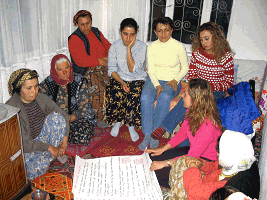
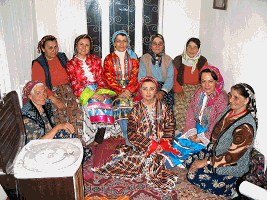
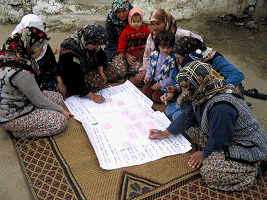
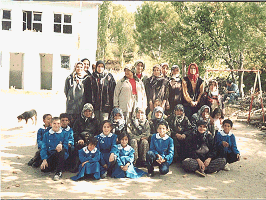
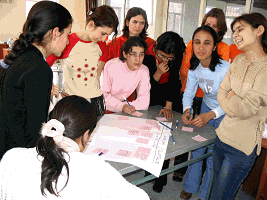
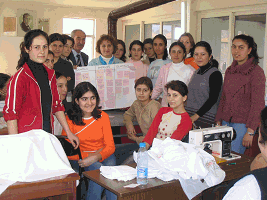
Figure 3.2. Surveys of village women.
• The seeds of Stone Pine trees can easily be used for seedling production. Trees aged 20-25 give an average of 50 cones, with a yield of 60 grams of seeds per cone. Seeds sowed in fertilizer, creek sand and fossils in the spring germinate within 10 days. Grown seedlings are transferred to the field in the autumn or the following spring.
• Stone Pine trees are regularly fertilized with manure. Fertilizing began after it was observed that animal waste aids tree development in grazing lands. As a result of this fertilizer, tree development has accelerated, with increased quality.
• Pruning has also been initiated in recent years.
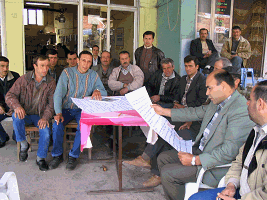
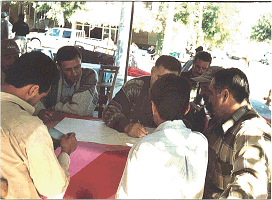
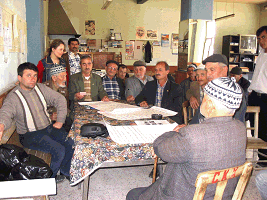
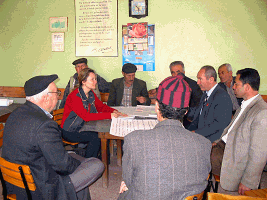
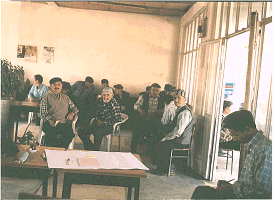
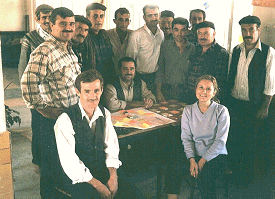
Figure 3.3. Surveys of village men.
• The products of Stone Pine trees are natural, since no chemical fertilizers or insecticides are used in their cultivation.
• Stone Pine processing cooperatives have ensured a balanced market (as detailed in section 3.3.3, below). State subsidies and credits play an important part in this.
Table 3.1 Views on Stone Pine Cultivation in Kozak by Village
Village or Group |
Gender |
Positive (%) |
Negative (%) |
Forest District Directorate personnel* |
Male |
61.5 |
38.5 |
Çamavlu |
Male |
56.2 |
43.8 |
Çamavlu |
Female |
35.3 |
64.7 |
Yukarıbey |
Male |
56.2 |
43.8 |
Aşağıbey |
Male |
50.0 |
50.0 |
Aşağıbey |
Female |
60.0 |
40.0 |
Kıranlı |
Male |
48.2 |
51.8 |
Kıranlı |
Female |
23.3 |
76.7 |
Demircidere |
Male |
70.6 |
29.4 |
Demircidere |
Female |
72.7 |
27.3 |
Terzihaliller |
Male |
18.8 |
81.2 |
Karaveliler |
Male |
60.5 |
39.5 |
Karaveliler |
Female |
70.0 |
30.0 |
Kaplan |
Male |
68.7 |
31.3 |
Average |
Male and Female |
53.1 |
46.9 |
*Not included in the average.
Figure 3.4. Views and ideas of stakeholders on the management of Stone Pine forests in Kozak.
• Villagers complain about not receiving registrations of Stone Pine lands located in state forests. Cadastral problems persist in the villages of Yukarıbey, Çamavlu and Güneşli.
• Nut collection is a difficult and dangerous business which can lead to injury or death due to trees falling during harvesting. There is no social security for nut collectors.
• Due to harsh weather condition, in recent years some Stone Pine trees have dried out.
• Demand from the domestic market is considered very low, and product promotion in insufficient.
• Villagers do not want the state to allocate land to outsiders, as they believe this will lead to both disputes and fire hazards.
• They complain about not being able to harvest on their own lands without first getting permission from the forest service.
• Young people living in the region are not fully aware of its problems. They believe that the pine nuts are an inexhaustible resource.
• Some villages (in Terzihaliller and Yukarıcuma, etc.) were to be included in Stone Pine afforestation 20 years ago. However, the villagers were opposed to this idea since their mines were producing good incomes then, and so there was no afforestation.
• Villagers planted Stone Pines in Treasury lands within village boundaries, but when these areas were opened for mining, the trees were uprooted.
• Beehives in private and state forests are prohibited due to the risk of fire. This creates problems for beehive owners and cuts their honey production, and also leads to disputes between nut producers and beehive owners.
• Seedlings are destroyed during the grazing of small animals in Stone Pine areas.
• Air pollution caused by dust has increased due to increasing numbers of mines in the region, and this has damaged the pine trees.
• Mineral extraction has caused the water table to drop, and this has hurt pine nut development.
• They want degraded forestlands (2-B lands; see section 3.1.1.2) in the region to be given to them at cost, and to be planted with Stone Pines.
• They want to be given the registrations of lands identified as forestland during the cadastral study whose products they have nevertheless utilized in the many years since.
• They want to be given the registrations of newly planted areas in state forestlands.
• They want to be able to harvest in their registered lands without needing permission from the Forest Department.
• They want it clarified whether the Stone Pine is a forest or fruit tree. (However, there is actually no legal problem in this regard).
• They want diseases afflicting Kozak’s Stone Pines to be researched in depth and they want to learn about this subject.
• Villages that were opposed to Stone Pine plantations at the beginning say that they lost in the long run and so want measures taken for their own Stone Pines as soon as possible.
• Nut producers want plantations with flowering species established in grazing lands to improve apiculture, so that beekeepers will stay away from nut-producing lands and the fire risk will be diminished.
• They want increased emphasis placed on such products as walnut and chestnut as well as Stone Pines.
• As the Stone Pine region is an source of income for them, they say the Forest Department should keep a fire engine on constant duty to protect against forest fires.
• They want the export of Stone Pine nuts to be supported and the supply and demand balance better established, and want necessary measures taken in this direction.
• They want standardization established for pine nuts. The villagers’ aim is to trademark the nuts under the brand name “Kozak.”
Family life is one of the basic elements of Kozak’s traditional Turkish community structure. As it is a rural area, family ties are very strong. There is little migration from Kozak, that is, nobody has left the villages except for in recent years people going to Bergama as well as nearby provinces. However, other rural areas in Turkey have seen constant population migration.
In the traditional Turkish village system young people usually live with their parents after marrying, and a patriarchal family structure is prevalent. However, large families are no longer the norm in Kozak villages, having been displaced by nuclear families as a result of young couples establishing new households. Family leaders continue to be mainly men. However, family structures have been moving towards more democratic modes in villages located mainly in the western part of the region.
Young people in the region get married through a process of interviews and negotiation. Dating is certainly practiced before matrimony, and parents listen to the wishes of their children. The legal marriageable age for girls is 18, and for boys 21, once they have completed their military service. Marriages are certainly legally registered, but religious registration is also done. In recent years, exogamic marriage with village outsiders has been seen, but not often in this region. There is still great distrust of divided land ownership arrangements and ownership by outsiders.
Kozak is known as one of the richest regions of Bergama. The villagers’ main income sources are pine nuts (60%), animal husbandry (30%), and grape, olive and apple cultivation (a combined 10%).
Villagers call the Stone Pine which has benefited them so greatly “Clever Pine,” and the Pinus brutia is called “Crazy Pine.” According to a local saying, the Stone Pine knows very well when to yield its products. Maintenance of the Stone Pine is easy and economical and brings good returns. There are natural Stone Pine growing areas in Kozak’s western villages. Villagers have also been working to plant the trees in the eastern parts of the region both by themselves and with the support of the Forest Department (Figure 3.5).
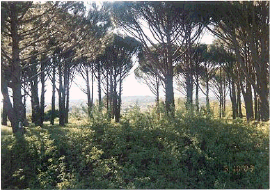
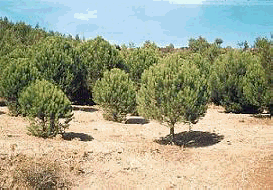
Figure 3.5. Natural Stone Pine forests and plantation areas in Kozak.
The villages of Demircidere, Aşağıbey and Hisarköy have practiced vineyard cultivation. In recent years, they have invested in grape cultivation through using a portion of their revenues from nuts.
Stone Pines planted in eastern Kozak have not yet reached the maturity necessary to yield products. The main income source there is animal husbandry, which has especially spurred development in the village of Çamavlu. (Figure 3.6). In other villages of the region people put emphasis on animal husbandry among new investments, and a rise in the number of animals has been seen. The number of goats in the region at large, by contrast, has fallen. Since the goats damage nut-growing areas, villagers have instead concentrated on herding mainly hybrid large animals or purebreds. There is a total of 63,000 ha of grazing land in the region, as follows: 23,000 ha in Çamavlu, 20,000 ha in Kıranlı and 20,000 ha in Güneşli. The grazing land of Çamavlu has been improved through the efforts of the Foundation to Combat Erosion (TEMA). Forest areas are also used as feeding areas for livestock, beside the grazing lands proper. Goat breeding has shown an increase in the villages of Okçular and Terzihaliller, since the forest there is not used as animal feeding grounds due to mines and a lack of land for grazing. The overall fall in the number of goats has been pronounced in villages which have plantation areas (Table 3.2).
Natural chestnut areas are located in the upper part of Güneşli close to Mt. Madra, and villagers collect the nuts after paying a tariff. The villagers there hope to boost their incomes by improving these areas.
There is a private trout farm in the region, as well as an initiative to produce edible mushrooms, but little interest has been shown. The collection of wild mushrooms remains the dominant practice.
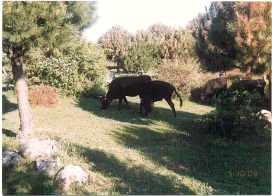
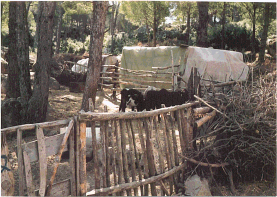
Figure 3.6. One of Kozak’s most important income-generating activities is animal husbandry (agroforestry).
Table 3.2 Changes in the Number of Animals Over the Last Decade in Kozak
Village |
Number of animals in 2003 |
Number of animals in 1993 |
||||
Cattle |
Sheep |
Goats |
Cattle |
Sheep |
Goats |
|
Aşağıbey |
700 |
180 |
50 |
421 |
- |
370 |
Aşağıcuma |
500 |
250 |
- |
560 |
426 |
- |
Ayvatlar |
37 |
20 |
135 |
288 |
210 |
325 |
Çamavlu |
1,050 |
3,000 |
300 |
1,570 |
7,000 |
1,440 |
Demircidere |
350 |
100 |
150 |
166 |
77 |
281 |
Göbeller |
600 |
120 |
225 |
333 |
147 |
486 |
Güneşli |
104 |
2,000 |
- |
85 |
1,640 |
187 |
Hacıhamzalar |
167 |
125 |
150 |
310 |
280 |
400 |
Hisarköy |
209 |
110 |
400 |
210 |
35 |
930 |
Kaplanköy |
80 |
740 |
350 |
35 |
800 |
600 |
Karaveliler |
1,500 |
1,000 |
80 |
1,130 |
820 |
340 |
Kıranlı |
1,200 |
1,500 |
300 |
940 |
1,220 |
540 |
Okçular |
128 |
142 |
370 |
125 |
70 |
150 |
Terzihaliller |
1,050 |
860 |
420 |
890 |
750 |
380 |
Yukarıbey |
1,500 |
1,000 |
450 |
2,300 |
1,020 |
420 |
Yukarıcuma |
450 |
700 |
480 |
485 |
940 |
645 |
Grand total |
9,625 |
11,847 |
3,860 |
9,848 |
15,435 |
7,494 |
Since 1983 there has been increasing granite exploitation in Kozak. Production has been improved as high-tech methods have replaced simple, more traditional methods. In order to do minimal harm, production has been pursued with the requested scale and quality. Nine establishments process the stone and employ some 300-350 people. There are also outsiders from other provinces and towns who work in the region. Some 500 tons of granite are produced annually in these establishments. Some 200 tons of this granite is exported from the port of Dikili, with the rest going to the domestic market. These exports bring in some 11.55 trillion Turkish liras to the economy.
Stone mines in the villages of Terzihaliller and Yukarıcuma are also important income sources for the region (Figure 3.7). Although some villagers dislike and complain about these mines, they do know that in their particular areas, the revenues from stone workings and exports total more than revenues from nuts. In 1985, the Forest Department sought to establish Stone Pine plantations in these two villages, but villagers who used oak branches to feed their animals were opposed, as the oaks would have been uprooted and replaced by Stone Pines. When, however, the villagers saw the economic benefits to villages where plantations started yielding products, they themselves planted Stone Pine in the Treasury and grazing lands. Some plantations in the Treasury lands have been uprooted due to clearing the region for mining. Reforestation of these places will only be done after the stone extraction is completed. However, productivity in the plantation areas established in the villages of Karaveliler and Kıranlı has been on the rise, with the villagers’ economic situation showing constant improvement.
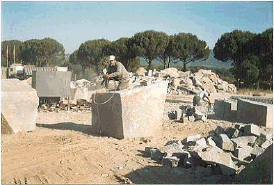
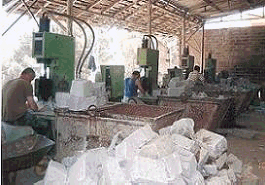
Figure 3.7. Granite processing.
Drawing on the studies of Kozak region villagers, Table 3.3 classifies and shows the region’s income sources and who benefits from them.
Table 3.3 Sources of Livelihood of Kozak Villagers and Who Benefits
Income source |
Benefiting group | ||
Villagers |
Outsiders |
The state | |
Stone Pines |
5 |
3. 5 |
2. 5 |
Vineyards |
4 |
3. 5 |
0. 5 |
Animal husbandry |
4 |
- |
2 |
Transportation |
3 |
1 |
- |
Timber production |
- |
- |
2. 5 |
Mushrooms |
5 |
- |
- |
Chestnuts |
5 |
- |
- |
Note: This was prepared in accordance with the working group studies with villagers.
Large changes in Kozak’s socioeconomic conditions have been seen with rising income levels in line with the development of Stone Pine production and exports.
The use of modern electronic devices and goods has risen in households due to increases in individuals’ buying power. This situation is most pronounced in villages with natural Stone Pine areas. In villages that are rich due to pine nut production such as Aşağıbey and Yukarıbey, central heating systems have been established, while the villages in eastern Kozak are still in the development stage and so still use stoves for heating. Nutshells or bark are used as fuel.
The practice of taking holidays, normally rare in village communities, is in contrast quite common in Kozak. It is especially very common in villages in western Kozak, where all the villagers have summerhouses on the coast. Individuals speak of vacations by the sea as necessities.
The importance placed on education for young people has risen with increases in the general welfare. A high school has opened in the village of Yukarıbey with the contributions of the locals. The school has computer, science and language labs and it produces successful students. With the help and efforts of the National Town Education Directorate and village legal entities, activities for youths have been organized, with courses in computers, foreign languages, folk dance, and various handicrafts offered in order to help young people fill their free time and better themselves.
Recently, cultural entertainments have also begun in the region. Wrestling and camel wrestling festivals whose proceeds benefit schools and education have been organized in the villages of Aşağıbey and Yukarıbey. Local businessmen have placed advertising in calendars prepared on behalf of the village union, whose proceeds again benefit education.
An initiative has begun in Aşağıbey to organize a grape harvesting fair to encourage grape cultivation and support grape producers after 2004. There are proposals to set up a fairgrounds/marketplace in the center of Yukarıbey to better display local products. There individuals plan to sell their own products such as grapes, jams, nuts, sweets and cheeses. Land has already been allotted and arrangements are being made for the project. They also plan to organize ecotourism activities through future enlargement of the marketplace area.
One local area visited by tour groups on a daily basis is also among the hiking routes of İzmir mountaineering clubs. Although they come to hike, mountaineers buy products produced by the villagers. A Demircidere tea garden owned by a local woman, previously mentioned in section 3.1.1.3, is an excellent example of entrepreneurship by women.
A pine nut cooperative sells processed nuts as ecological products. Connections were made with various firms with the idea that this would later be extended to other agricultural crops, thus making the region an ecological agricultural center. These initiatives are due to be expanded when newer Stone Pine plantation areas reach the age of maturity.
Revenues from Stone Pine production have caused some in the region to seek alternative income sources. Especially villages in eastern Kozak have increased investments in animal husbandry and apiculture due to the limitations of Stone Pine lands. This could help to ensure that the regional economy is diversified and flexible.
Development of the region’s socioeconomic structure has created a unity not seen in most parts of the country, including the development of business cooperatives.
Market balances are safeguarded by the Yukarıbey Stone Pine processing cooperative, which was established in league with other villages. Before the cooperative was founded, traders usually made late payments since they were buying the product at cheap prices that they themselves set. However, now producers are able to bargain with the traders and receive payment in cash as soon as they sell. The Stone Pine processing cooperative pays a stoppage (source collection) tax to the state for the products, and this money comes from the owners of the products, whereas previously there were no official records on products sold to traders. This way, at least the amount sold to the cooperative from Stone Pine production on private lands is recorded and the state earns something from Stone Pine production. Most of the villagers consider this progress. However, some don’t want to sell products to the cooperative due to this tax. Especially in Kaplan, individuals usually sell their product to traders, with very few villagers belonging to the cooperative.
The cooperative has a one-time membership fee of 250 million Turkish liras. It pays attention to the quality of the products on sale, and does not buy products brought from other provinces, as their quality is low due to early harvesting. Nor does the cooperative buy from non-members. If they wish, cooperative members can sell some of their products to traders. There is no limitation on this. Members do not sell all their products at once. The cooperative stores the members’ products in its depots free of charge, thus allowing them sell these products to the cooperative or traders in whatever amount whenever they want. Hence, villagers can convert their products to cash whenever they wish to do so. Moreover, producers do not suffer losses due to price fluctuations. The Ministry of the Environment and Forestry’s General Directorate of Forest and Village Relations (ORKÖY) gives credit support to the cooperative.
The second large cooperative in the region is the Çamavlu Agricultural Development Cooperative. This establishment began as a simple enterprise at the end of the 1970s which was later improved by periodic investments, and by 1998 it was a cooperative with a processing capacity of 20 tons of milk per day. It currently has 625 members from 15 villages. The cooperative has led to improvements in Kozak in animal husbandry for milk. Villagers have been encouraged to breed cultured stock, and technical and monetary support has been provided for fodder crop production, slag production and animal health measures. The cooperative has benefited from credits from the Ministry of the Environment and Forestry and the Ministry of Agriculture and Village Affairs.
In recent years the development of apiculture and increased honey production has attracted rising interest, especially in the villages of Kıranlı and Karaveliler. A third cooperative, the Kıranlı Agricultural Development Cooperative, was founded with the support of the Ministry of Agriculture and Village Affairs to seek better prices for honey. The cooperative has honey-wrapping units of 20 kg, 500 kg and 1,000 kg. Villagers hope to sell their honey under the “Kozak” label. Therefore, they are working to invest in boosting their honey production capacity and the number of beehives. Some are seeking for the town agriculture directorate to establish plantations for flowering tree species in current grazing lands.
Cooperatives in the region are important not only for reaping increased benefits from village products, but also for providing jobs.
Pine nut exports are the base of cultivation in the Kozak region. Some 900-1,000 tons of Turkey’s production of 1,200-1,300 tons are met by the region, and 80% of this amount is exported.
A number of countries buy pine nuts from Turkey, and key among them are Italy, the United Arab Emirates, the United States, Spain, Switzerland, Germany and Israel. Pine nut imports from the People’s Republic of China into Turkey began in 1993, and imported pine nut products are sold on the domestic market. Most of these imports come from China, Pakistan and Iran. However, since 2000 imports have also been seen from Italy, Uzbekistan and Spain as well (Table 3.4), and these nut imports have hurt local producers, who want to boost domestic production and restrict or ban imports. A dry climate has also damaged the export balance in recent years.
Table 3.4 Fluctuations in Export/Import Values of Pine Nuts Over the Last Decade
Year |
Exports |
Imports |
||
Amount (kg) |
Value ($) |
Amount (kg) |
Value ($) |
|
1992 |
446,680 |
8,401,187 |
- |
- |
1993 |
277,700 |
4,699,062 |
5,380 |
8,608 |
1994 |
302,710 |
2,693,513 |
40,650 |
134,958 |
1995 |
261,508 |
1,804,908 |
53,500 |
218,280 |
1996 |
456,270 |
5,649,314 |
15,000 |
79,564 |
1997 |
824,523 |
11,586,172 |
27,580 |
20,234 |
1998 |
859,479 |
16,408,290 |
57,787 |
29,275 |
1999 |
398,796 |
6,094,139 |
163,879 |
453,396 |
2000 |
165,983 |
2,262,965 |
142,822 |
163,377 |
2001 |
363,497 |
3,825,048 |
215,653 |
1,015,618 |
2002 |
765,018 |
10,355,524 |
40,975 |
376,105 |
Examining unit prices for exports shows that they reached their peak in 1998. Since then, export prices have fallen, while import prices have seen large jumps recently, albeit with some fluctuations (Figure 3.8) Local producers are worried about price stability. However, over the last year the unit price for nut imports has risen somewhat and come closer to the export price.
Besides the revenues it provides to the region, the Stone Pine has had a huge impact through creating jobs. Men work to get the cones down from trees, and the women work in the collection, drying and selection process. In some cases, the labor pool in the village is insufficient and workers are brought in from neighboring villages.
Figure 3.8. Annual export and import unit prices of pine nuts (without bark).
Kozak’s total population is 7,918, with 3,228 households (Table 3.5). The average household has 2.45 people. The structure of Kozak is akin to that of European countries. The number of children per family is 1-2 where there is no need for a large labor force, though in rural areas this figure is usually high due to children being used as workers. The villages with populations greater than 500 are Yukarıbey, Karaveliler, Çamavlu, Aşağıcuma and Karaveliler. Children make little economic contribution to their families; on the contrary, a surfeit of children means dividing the Stone Pine lands into pieces for inheritance. In past times, converting these lands into many small pieces and patches has been a serious problem. Land patches belonging to a single person are often scattered, which makes maintenance and collection difficult. Lots that are overly small as well as inaccessible are sometimes left fallow without being harvested. Villagers in the Kozak region who don’t want their lands divided practice birth control. Kozak’s population has fallen in recent years, bucking the trend of other regions (Figure 3.9). Despite their very low-level population increases over time, all Kozak’s villages have dynamic young populations. Again, this is quite different from the elderly domination of most other villages in Turkey.
Table 3.5 Kozak’s General Demographic Structure (2000)
Village |
Total population |
Number of women |
Number of men |
Number of households |
Aşağıbey |
718 |
357 |
361 |
347 |
Aşağıcuma |
738 |
344 |
394 |
261 |
Ayvatlar |
379 |
179 |
200 |
143 |
Çamavlu |
708 |
359 |
349 |
296 |
Demircidere |
216 |
103 |
113 |
130 |
Göbeller |
445 |
217 |
228 |
115 |
Güneşli |
250 |
130 |
120 |
82 |
Hacıhamzalar |
274 |
141 |
133 |
113 |
Hisarköy |
242 |
114 |
128 |
78 |
Kaplanköy |
432 |
208 |
224 |
199 |
Karaveliler |
833 |
408 |
425 |
300 |
Kıranlı |
466 |
239 |
227 |
179 |
Okçular |
355 |
176 |
179 |
150 |
Terzihaliller |
380 |
200 |
180 |
155 |
Yukarıbey |
1,306 |
640 |
666 |
600 |
Yukarıcuma |
232 |
124 |
108 |
80 |
TOTAL |
7,974 |
3,939 |
4,035 |
3,228 |
Figure 3.9. Annual changes in the population of the Kozak region.
A high level of awareness, education and economic development in the region is reflected in the general structure of the villages.
There is no education problem in Kozak, which is overwhelmingly literate, except for a handful of its oldest residents. There are primary schools in the villages of Aşağıbey, Aşağıcuma, Çamavlu, Göbeller, Karaveliler, Kıranlı and Yukarıbey. Children in other villages are sent to the schools in Aşağıbey or Yukarıbey, based on their proximity via transportation. After graduating from primary school, children go to middle school in Aşağıbey or Yukarıbey, and then go to high school in Yukarıbey or in town (Table 3.6).
Family leaders in Aşağıbey believe that the revenues they earn from pine nuts will suffice for their livelihood and so have concluded that educating their children is pointless. Therefore, the number of its children who continue beyond primary education is very low. A similar pattern can be seen in other regional villages. Although the villagers are ambivalent about this practice, they think that by doing this they will prevent their children from moving far away from their houses and villages. In brief, they believe it is crucially important to keep youth within the region. This situation was clearly demonstrated in interviews with young girls especially in Aşağıbey, who showed little interest in their region. However, families in other villages of the region send their children to school as long as they wish, and support them whatever way they can. If we take into account that there is a high school in Yukarıbey, the emphasis placed on education will be understood better.
Health care: There is a fully equipped health center in the central village of Yukarıbey. Villagers firstly come to the Yukarıbey health center, then they go to the town or province if their problems have not been solved. In addition, mobile mother and child health teams provide checkups and health services from time to time.
Transportation: The road connecting Kozak’s villages to Bergama is made of asphalt. Within the villages the roads are very level and comfortable, though not made completely of asphalt. Regular bus service is provided from Yukarıbey to Bergama (Table 3.6).
Table 3.6 General Information on Kozak’s Infrastructure (2000)
Village |
Village road |
Drinking water |
School |
Sewage system |
Aşağıbey |
Asphalt |
Sufficient |
Open |
Yes |
Aşağıcuma |
Asphalt |
Sufficient |
Open |
Yes |
Ayvatlar |
Asphalt |
Sufficient |
Carrying |
Yes |
Çamavlu |
Asphalt |
Sufficient |
Open |
Yes |
Demircidere |
Asphalt |
Sufficient |
Carrying |
Yes |
Göbeller |
Asphalt |
Sufficient |
Open |
Yes |
Güneşli |
Asphalt |
Sufficient |
Carrying |
Yes |
Hacıhamzalar |
Asphalt |
Sufficient |
Carrying |
Yes |
Hisarköy |
Asphalt |
Sufficient |
Carrying |
Yes |
Kaplanköy |
Asphalt |
Sufficient |
Carrying |
Yes |
Karaveliler |
Asphalt |
Sufficient |
Open |
Yes |
Kıranlı |
Asphalt |
Sufficient |
Open |
Yes |
Okçular |
Asphalt |
Sufficient |
Carrying |
Yes |
Terzihaliller |
Asphalt |
Sufficient |
Carrying |
Yes |
Yukarıbey |
Asphalt |
Sufficient |
Open |
Yes |
Yukarıcuma |
Asphalt |
Sufficient |
Carrying |
Yes |
Communications: At present there are telephones in all villages and every house, though only 7-8 years ago few houses had telephones. There is no problem with communications.
In addition to providing other services, the muhtar (village leader) has the garbage collected once a week. Beside this, garbage-hauling tractors have been received from the Environment Directorates. Local people who value the protection of nature and the environment pay attention to cleanliness.
The people of Kozak show great interest in better protecting and utilizing the region’s natural beauties and resources.
Kozak’s most important natural resource is its Stone Pine forests. In recent years local people have explored a wide variety of possibilities to improve Stone Pines through such practices as pruning and fertilizing. Through the former, lower, unproductive tree branches have been reduced. In this way such branches are prevented from sapping the tree’s nutrients, and better development of the trees is promoted.
In the early years of cultivation, late- and over-pruning led to productivity losses. Villagers are now better aware of the proper time for pruning.
3.7.1.1. Harmful Agents and Fungal Diseases
Among harmful agents causing problems for Stone Pines, the worst offender is the very common Palaeococcus fuscipennis, known locally as the “Ballı Basra.” However, the species is not being fought due to opposition from beekeepers, since it also promotes honey production. This has led to disputes between beekeepers and pine nut producers in the region. Trees that the insect targets cannot develop and flower from the bottom. These trees are covered with a sweet material which the insect exudes like cotton. Bees use this material for honey production.
Thaumetopaea phityocampa is also very common in the region. This insect mainly afflicts the Pinus brutia, not the Stone Pine, say the villagers. Another harmful agent in the region is the May Beetle, which affects the roots of trees. Biological control is very important for these harmful agents since spraying is expensive and can damage ecological cultivation. The locals want research to be done on this subject and proper training and preventative measures developed.
There has also been some damage caused by Polyporus pini, which frequently goes in towards trees’ scar sites and causes decay, as well as by Armillaria mellea and Trametas radiciperda, which cause harm especially in sandy soil. For the time being people are trying to combat these fungal diseases through early cutting in order to minimize the ill effects.
One important factor that in recent years has threatened Kozak’s natural health is drought. This dry climate has caused degradations of product quality and falls in productivity. Moreover, increases in the number of artesian wells dug for agriculture has caused the water table to fall, making it difficult for Stone Pines in villages at the lower watersheds to get sufficient water. People want the digging of artesian wells to be controlled, and a planned dam constructed in the region as soon as possible, in order to better manage water resources.
Smoke and silt from mines in Kozak causes air pollution in areas where the mines are most prevalent (mainly the villages of Yukarıcuma and Terzihaliller). In addition, the stone extraction causes the underground water table to fall. Degradation in the surface cover exacerbates erosion. All these factors have a negative effect on the cultivation of Stone Pines. At first villagers valued the mines as a crucial income source, but now they place more importance on the Stone Pine. Villagers said that the stones in the mines over time will be depleted and are non-renewable, but that Stone Pine production can always be increased. In addition, they complained that the mines threaten the Stone Pines and nature itself due to erosion (Figure 3.10).
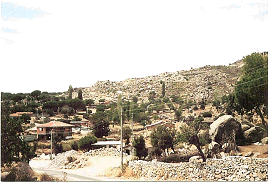
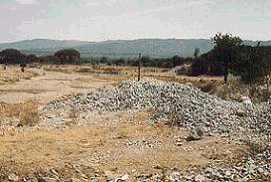
Figure 3.10. The environmental impact of mines.
Close planting of Stone Pines to create smooth stems has delayed the onset of maturity (and thus products) and hurt the quality of afforestation-purpose plantings, especially in state forest areas. Planting distances have been increased in recent years with a larger emphasis on fruit production. This has been initiated to ensure sufficiently large growing room by thinning out trees in plantation areas. New regulations stipulating planting distances of 6x6 or even 10x10 meters on plantations have helped. This problem has been seen in production areas in state forests rather than in the Kozak region.
The most recent fire in the region occurred in 1974 and was quickly extinguished. Villagers are very sensitive to this threat and are ready for emergencies. Fire prevention and protection measures are crucial since private lands are very close to the state forests. However, if a fire breaks out, it could spread quickly, since the trees are of roughly equal height and are adjacent to each other. Villagers concerned about this threat said that they planned to buy a fire engine for the region as soon as possible.
The onset of Erosion has been seen in grazing lands belonging to the villages of Çamavlu, Kıranlı and Karaveliler, beside areas where the mines are concentrated. There is no erosion in Stone Pine areas carefully maintained by villagers. The villagers value nature and so want to take immediate erosion control measures. Therefore, the grazing lands need to be improved and afforested using high-quality seeds. Plantations with flowered species in the grazing lands where the erosion risk is great will create production potential for beekeepers and reduce the pressure on Stone Pine areas. Hence, the problems between beekeepers and nut producers will be partially addressed. Moreover, trees planted in the grazing lands will provide shade for animals both large and small and aid cultivation. At present animals are unable to find suitable places to rest during extreme heat.
The Stone Pine extends naturally in China, northern and northeastern Mediterranean countries, Spain (up to 1,000 meters), Afghanistan, Pakistan, eastern Italy, Dalmatia (in Croatia), Macedonia and Grit Island.
Some 20-25,000 tons of pine nuts are produced worldwide each year. The People’s Republic of China has the biggest market share, with 10,000 tons of production, followed by 5,000 tons each in Afghanistan and Pakistan, 3,000 in Spain, 1,300 in Turkey, 850 in Portugal, and 400 in Italy (Table 3.7). The production of other Mediterranean countries is at lower levels. Spain has enhanced its competitiveness by upgrading its plantation areas, and China has done the same through production over large areas (Figure 3.11).
Table 3.7 Important Stone Pine Nut-Producing Countries
Country |
Annual production amount (tons) |
People’s Republic of China |
10,000 |
Afghanistan |
5,000 |
Pakistan |
5,000 |
Spain |
3,000 |
Turkey |
1,300 |
Portugal |
850 |
Italy |
400 |
Figure 3.11. Countries’ shares of worldwide Stone Pine production (%).
Pine nuts are grown in Turkey’s Aegean region, Mediterranean islands, and the coasts and valleys around Kahramanmaraş. There are 10 areas where pine nuts are grown intensively:
§ Bergama’s Kozak region, along the Kozak Creek and its tributaries, at altitudes of 120-700 meters,
§ On the northeast slope of the Çoruh River through the village of Neşvikiye, at altitudes of 150-600 meters,
§ The Kalenema and Maligane Creeks close to Trabzon-Akçaabat, on the northeast slopes at 15-500 meters of altitude,
§ Along the north coast of Gemlik Bay and the Yılandere region, at altitudes of 400-500 meters,
§ At Balaban Creek of Seydişehir-İzmir, at altitudes of 100-150 meters,
§ Among the villages of Torbacı, Helvalı and Dağteke, at altitudes of 400-500 meters,
§ The Mazon mountain range of Aydın, the Beypınar Forests next to Milas, the southern slopes of Mt. Mardan in Muğla, and the Karaova and Gökbey regions of Bodrum, at altitudes of 300-860 meters,
§ Some 30-40 km at a width of 100-150 m (at the shoreline) from Kumköy to Manavgat Creek in Antalya’s Serik township, at sea level
§ At altitudes of 600-900 meters in the village of Onsen of Kahramanmaraş,
§ Edremit Bay and the coasts and the village of Küner in western Anatolia.
Nuts originally from Turkey, Spain, Portugal and Italy known as “Turkish Nuts” on world markets have a reputation for better quality and so fetch higher prices than those from China, Afghanistan and Pakistan. Therefore, Turkey holds an important place in pine nut cultivation, but it has yet to fulfill its expected potential.
Turkey’s total pine nut cultivation area covers some 69,115.5 ha. Out of this total, 51,185.5 ha is in state forest areas, 50,496.5 ha of which lies outside of Kozak in afforestation areas and natural forests, and 689 ha of which is private afforestation areas inside Kozak. The remaining 17,930 ha lie entirely on private Stone Pine forests in Kozak, 16,500 ha of which belongs to individuals, with the remaining 1,430 ha belonging to village legal entities. (Figure 3.12)
Figure 3.12. Distribution of Turkey’s Stone Pine areas by ownership category (%).
Turkey’s total annual pine nut production totals some 1,200-1,300 tons. In recent years both the amount and quality of production have fallen due to very dry conditions, choking off exports while imports have risen to meet domestic demand.
Stone Pine forests cover 0.25% of Turkey’s state forests and are classified in the “high forests” category, making up 0.35% of high forest areas. There are Stone Pines in 17 forest district regions in the forests. The largest areas are in the districts of Muğla, İstanbul, İzmir and Balıkesir (Table 3.8).
There are seed stand areas within seven forest district regions. The largest such area covers some 754 ha in the Kahramanmaraş forests. Gene conservation sites, taking into account the varying ecological conditions of cultivation sites, have been established in the provinces of Artvin and Muğla (Table 3.8).
Breaking down the Stone Pine areas in state forests, we see that 95% is production forest (timber production purpose), 4% is seed stand area, and 1% is gene conservation sites (Figure 3.13).
Turkey produces some 1,300 tons of pine nuts annually from the total 51,185.5 ha of Stone Pine areas in its state forests. Trees produce products from 13 state forest regions, with most of this coming from the forests of Balıkesir, Çanakkale and Muğla. Stone Pines in Antalya have been planted for the purpose of holding down sand dunes in coastal areas. Cone production is low for these trees since the local winters are insufficiently cold, and production from mature cones is absent due to empty seeds. No production has been recorded in the districts of Artvin, Bolu, Isparta or Kütahya (Table 3.9).
The highest productivity per unit area among production areas is seen in the Kahramanmaraş district (Table 3.9). Stone Pines on the edges of this district usually have a degree 1 closure canopy or are in the category of degraded forests.** The paucity of trees in the area positively affects both productivity and sun exposure.
Table 3.8. Locations of Stone Pines in Turkey’s State Forests
Forest district regions |
Forest areas of the region (ha) |
Stone Pine areas (ha) |
Percentage in the region (%) |
||
Production forests |
Seed stands |
Gene conservation areas |
|||
Adana * |
857,904 |
911 |
- |
- |
0.1062 |
Adapazarı * |
362,542 |
107 |
- |
- |
0.0295 |
Amasya* |
846,977 |
23 |
- |
- |
0.0027 |
Antalya* |
1,070,779 |
2,104 |
543 |
- |
0.2472 |
Artvin |
390,449 |
5 |
- |
148. 5 |
0.0393 |
Balıkesir * |
652,479 |
4,937 |
278.5 |
- |
0.7993 |
Bolu |
590,253 |
1,493 |
- |
- |
0.2529 |
Bursa * |
750,944 |
3,441 |
239.5 |
- |
0.4901 |
Çanakkale* |
636,759 |
1,385 |
83.0 |
- |
0.2305 |
Denizli* |
717,940 |
13 |
- |
- |
0.0018 |
Isparta |
716,995 |
112 |
- |
- |
0.0156 |
İstanbul* |
602,325 |
6,480 |
- |
- |
1.0758 |
İzmir* |
987,929 |
5,287 |
122.5 |
- |
0.0156 |
K. Maraş * |
963,773 |
179 |
754.0 |
- |
0.0968 |
Mersin * |
803,993 |
236 |
48.0 |
- |
0.0353 |
Muğla * |
1056,486 |
22,057 |
- |
153. 5 |
2.1023 |
Kütahya |
612,542 |
32 |
- |
- |
0.0052 |
Zonguldak |
529,740 |
13 |
- |
- |
0.0025 |
Total |
13,150,809 |
48,815 |
2,068.5 |
302 |
- |
Total high forests 14,506,872 |
Total Stone Pine areas 51,185.5 |
Total forest area 20,667,054 |
|||
0.35% |
0.25% |
||||
* Regions where there is Stone Pine cone production. Recorded production is not available for other regions.
Figure 3.13. Distribution of Stone Pine areas in state forests by function (%).
Table 3.9 Production Values of Stone Pine Cones in State Forests by Region (According to the 2001 Inventory of Non-Wood Forest Products)
Region |
Area (ha) |
Production of nuts with bark (kg) |
Productivity of nuts with bark (kg/ha) |
Prices of nuts with bark (TL/kg) |
Production of nut seeds (kg) |
Adana |
911 |
48,080 |
52.78 |
73,000 |
12,020 |
Antalya |
2,104 |
39,548 |
18.80 |
12,382 |
9887 |
Balıkesir |
4,937 |
593,692 |
120.25 |
127,548 |
148,423 |
Mersin |
236 |
73,960 |
313.9 |
60,000 |
18,490 |
Amasya |
23 |
530 |
23.04 |
231,000 |
133 |
İstanbul |
6,480 |
108,100 |
16.68 |
81,625 |
27,025 |
Muğla |
22,057 |
159,755 |
7.24 |
22,220 |
39,939 |
Çanakkale |
1,385 |
162,500 |
117.33 |
12,000 |
40,625 |
İzmir |
5,287 |
46,827 |
8.86 |
12,993 |
11,707 |
Bursa |
3,441 |
5,000 |
1.45 |
10,000 |
1,250 |
Adapazarı* |
107 |
0 |
0 |
- |
0 |
Denizli* |
13 |
0 |
0 |
- |
0 |
K. Maraş |
179 |
64,000 |
357. 5 |
12,000 |
16,000 |
TOTAL |
47,160 |
1,301,992 |
- |
76,831 |
325,499 |
*No production in 2001.
Note: 2001 tariff prices have been taken into account in prices.
The Stone Pine areas of Bursa and İzmir usually have a closure canopy of degree 3. This means that 71-100% of the land is covered by trees. This shows that development might have been negatively affected (Figure 3.14).
Examination of the annual production value of Stone Pine areas in state forests shows a large apparent increase. Production of nut seed of about 2,500 kg in 1990 has shown considerable rises since 2000. Efforts to boost the economic value and upgrade the Stone Pines have had a role in this. Thinning in Stone Pine areas inside state forests in recent years has increased productivity by prioritizing cone productivity. While in the past planting distances in plantations were 3x3 meters in order to create smooth stems, recently plantings have been carried out with distances of 6x6 meters or even 10x10 meters. The General Directorate of Forestry has been conducting thinning operations in study areas. Productivity should be boosted through thinning in the areas where canopy closure is high. Stone Pines in these areas were affected by the overall drought in 2002 which caused drops in production (Table 3.10).
The Kozak region holds an important place in Turkey in terms of Stone Pine production. Some 27% of Stone Pine forests in Turkey are located in Kozak, with the remaining 73% falling outside Kozak in state forests. Despite taking place in a small part of Kozak’s total
Figure 3.14. Canopy closure of Stone Pine areas in state forests.
Table 3.10 Annual Pine Nut Production (Tons) in State Forests
Year |
Amount of nut with bark (kg) |
Amount of nut seed* (kg) |
1990 |
10,000 |
2,500 |
1991 |
226,000 |
56,500 |
1992 |
271,000 |
67,750 |
1993 |
143,000 |
35,750 |
1994 |
267,000 |
66,750 |
1995 |
426,000 |
106,500 |
1996 |
418,000 |
104,500 |
1997 |
231,000 |
57,750 |
1998 |
541,000 |
135,250 |
1999 |
907,000 |
226,750 |
2000 |
1,471,000 |
367,750 |
2001 |
1,302,000 |
325,500 |
2002 |
830,000 |
207,500 |
Note: Nut production amount in the state forests have been calculated by the tariff prices paid by the individuals (total income / tariff price).
*1 kg nut seed is extracted from 4 kg nuts with bark.
Area, some 1,000 tons of Turkey’s annual production (1,300 tons) takes place in the region. This amounts to 77% of the production value, an exciting figure (Figure 3.15). Kozak’s production value surpasses that of entire countries such as Italy, Portugal, etc.
Figure 3.15. Comparison of Stone Pine production areas and pine nut amounts in Kozak and outside Kozak.
Stone Pines grow on a total area of 18,619.4 ha in the Kozak region. Out of this area, 16,500 ha is private land, 1,430 ha are areas belonging to village legal entities, and 689.4 ha are private plantation areas in state forests (Table 3.11). Stone Pines are grown on 61% of the land in the region.
Table 3.11 Development of Stone Pine Areas in the Kozak Region, 1987-2002 (Ha)
Year |
1987 |
2002 |
|||
Village |
Total area |
Total area |
Registered lands |
Village legal entity areas |
State (private plantation) |
Aşağıbey |
3,200 |
3,000 |
2,600 |
400 |
- |
Aşağıcuma |
900 |
1,200 |
1,000 |
200 |
- |
Ayvatlar |
900 |
700 |
700 |
- |
- |
Çamavlu |
100 |
500 |
500 |
- |
- |
Demircidere |
200 |
500 |
500 |
- |
- |
Göbeller |
1,000 |
10 |
940 |
60 |
- |
Güneşli |
400 |
400 |
400 |
0 |
49.5 |
Hacıhamzalar |
600 |
600 |
570 |
30 |
|
Hisarköy |
280 |
280 |
270 |
10 |
- |
Kaplanköy |
1,000 |
1,400 |
800 |
600 |
- |
Karaveliler |
1,600 |
1,900 |
1790 |
110 |
318.4 |
Kıranlı |
450 |
450 |
450 |
0 |
25.0 |
Okçular |
700 |
700 |
700 |
- |
- |
Terzihaliller |
200 |
200 |
200 |
0 |
97.0 |
Yukarıbey |
4,000 |
5,000 |
5,000 |
0 |
103.5 |
Yukarıcuma |
100 |
100 |
80 |
20 |
96.0 |
TOTAL |
15,630 |
18,619. 4 |
16,500 |
1430 |
689.4 |
Stone Pines have been established by plantations in the villages of Çamavlu, Güneşli, Karaveliler, Kıranlı and Terzihaliller. There are naturally grown trees and villager-grown trees in other villages. The largest nut areas among the villages are located in Yukarıbey, the biggest and most populated village. All the lands belong to individuals and are registered lands. Most natural Stone Pine areas belonging to village legal entities are located in the villages of Kaplan and Aşağıbey. Therefore, the villages’ budgets are very healthy. All private plantations are in areas rented on behalf of village legal entities, and villagers utilize these areas through the entities. The largest plantations are in the village of Karaveliler (Table 3.11).
Kozak’s private forest areas are hugely important. The total size of private forest areas in the rest of Turkey, just 14,853.4 ha, is dwarfed by that of Kozak’s private Stone Pine forests. These non-Kozak private forests with tree species beside Stone Pines are located mainly in İstanbul (Table 3.12).
Table 3.12 Distribution of Non-Stone Pine Private Forests in Turkey
Region |
Number of forests |
Area (ha) |
Adana |
8 |
406.5 |
Adapazarı |
109 |
2,174.0 |
Amasya |
7 |
1,209.0 |
Ankara |
8 |
124.1 |
Balıkesir |
12 |
785.5 |
Bolu |
17 |
158 |
Bursa |
39 |
372.6 |
Çanakkale |
23 |
148.7 |
Denizli |
19 |
145.5 |
Elazığ |
1 |
13.0 |
Eskişehir |
1 |
1,321.0 |
Giresun |
8 |
800.8 |
İstanbul |
63 |
4,515.8 |
İzmir |
16 |
455.1 |
K. Maraş |
5 |
570.1 |
Kastamonu |
4 |
199.5 |
Mersin |
3 |
32.0 |
Muğla |
25 |
622.2 |
Sinop |
1 |
800 |
Grand total |
369 |
14,853.4 |
Most of Turkey’s pine nut production takes place in the Aegean region. The region’s soil and climate offer ideal conditions for Stone Pine cultivation, and its best areas are found in Kozak. In 1928 productivity trials conducted in Turkey’s key pine nut growing areas, Bergama was identified as the most productive location for Stone Pines (Table 3.13). At present, the pine nut with the highest productivity and the best quality has been grown in Kozak, within Bergama’s boundaries.
According to another study, while 1,213 Kozak region-nuts with bark equal one kg, it takes 1,300 Italian nuts with bark to equal one kg; hence, Kozak nuts are bigger and better formed. The most important factors affecting Kozak’s productivity are its soil composition and climate. The soil, which is light and sandy and consists mostly of granite, ensures the ideal environment for root development.
Table 3.13 Results of Productivity Trials in Important Stone Pine-Producing Regions (1928)
Region |
Productivity (%) |
Bergama |
39.0 |
Söke |
29.3 |
Çine |
5.9 |
Bozdoğan |
1.2 |
Muğla |
1.2 |
Milas |
7.8 |
Aydın |
15.6 |
Total |
100 |
Looking at the climates of areas in Turkey where Stone Pines are grown shows that climate is the key beneficial factor for Kozak’s nut cultivation. The Kozak region is warmer than other regions, and trees meet its cooling needs. The humidity rate is sufficient for cultivation. Kozak’s average altitude is 500 meters, and damp air coming from the sea brings rainfall (Table 3.14).
Table 3.14 Comparison of Climatic Data of Important Stone Pine Regions in Turkey
Region |
Altitude (m) |
Annual average rainfall (mm) |
Average moisture (%) |
Average temperature (oC) |
Highest temperature (oC) |
Lowest temperature (oC) |
Antalya |
15 |
1178 |
67.5 |
18.5 |
43.7 |
-3.35 |
Çanakkale |
2 |
608.9 |
72.6 |
14.8 |
38.8 |
-11.5 |
Muğla |
557 |
929.8 |
58 |
15.3 |
40.57 |
-8.57 |
Manisa |
71 |
761 |
62 |
16.6 |
44.5 |
-17.5 |
İzmir (Kozak) |
500 |
839.8 |
61 |
16.0 |
35.0 |
-13.0 |
İzmir (Merkez) |
90 |
695 |
62.1 |
17.9 |
42.05 |
-7.48 |
Aydın |
57 |
677.5 |
63.0 |
17.7 |
43.0 |
-11.0 |
* 2-B land – so named as an abbreviation for Forest Law 6831, Article 2 – is land that used to be forestland but is no longer, and cannot legally be reclaimed as forestland, but can be considered for other purposes.
* A degree 1 canopy closure means that 11-40% of the land is covered by trees, degree 2 means 41-70% is covered, and degree 3 means 71-100% is covered. Degraded forest refers to canopy closure of 10% or less.